Comparative Analysis of Commercially Available Extracellular Matrix Soft Tissue Bioscaffolds.
引用次数: 0
Abstract
Decellularized extracellular matrix (dECM) products are widely established for soft tissue repair, reconstruction and reinforcement. These regenerative biomaterials mimic native tissue ECM with respect to structure and biology and are produced from a range of tissue sources and species. Optimal source tissue processing requires a balance between removal of cellular material and the preservation of structural and biological properties of tissue ECM. Despite the wide-spread clinical use of dECM products there is a lack of comparative information on these products Structurally, some dECM products showed a well-preserved collagen architecture with a broad porosity distribution, while others showed a significantly altered structure compared with native tissue. Decellularization varied across the products. Some materials surveyed (OFMm, PPN, PPC, OFMo, UBM, SISz, ADM, PADM and BADM) were essentially devoid of nuclear bodies (mean count of <5 cells per high powered field (HPF)), whereas others (SISu and SISb) demonstrated an abundance of nuclear bodies (>50 cells per HPF). Pathology assessment of the products demonstrated that OFMm, OFMo and PADM had the highest qualitative assessment score for collagen fiber orientation and arrangement, matrix porosity, decellularization efficiency, and residual vascular channels scoring 10.5±0.8, 12.8±1.0, and 9.7±0.7 out of a maximum total score of 16, respectively This analysis of commercially available dECM products in terms of their structure and cellularity includes 12 different commercial materials The findings highlight the variability of the products in terms of matrix structure and the efficacy of decellularization.市售细胞外基质软组织生物支架的比较分析
脱细胞细胞外基质(dECM)产品已广泛用于软组织修复、重建和加固。这些再生生物材料在结构和生物特性方面模仿原生组织的 ECM,可从各种组织来源和物种中生产。最佳的源组织处理要求在去除细胞物质与保留组织 ECM 的结构和生物特性之间取得平衡。尽管 dECM 产品已广泛应用于临床,但仍缺乏有关这些产品的比较信息。 从结构上看,一些 dECM 产品显示出保存完好的胶原结构和广泛的孔隙分布,而另一些产品则显示出与原生组织相比明显改变的结构。不同产品的脱细胞效果各不相同。调查的一些材料(OFMm、PPN、PPC、OFMo、UBM、SISz、ADM、PADM 和 BADM)基本上没有核体(平均每 HPF 50 个细胞)。产品的病理学评估表明,OFMm、OFMo 和 PADM 在胶原纤维取向和排列、基质孔隙度、脱细胞效率和残留血管通道方面的定性评估得分最高,分别为 10.5±0.8、12.8±1.0 和 9.7±0.7(总分最高)。这项对市售 dECM 产品结构和细胞性的分析包括 12 种不同的商用材料。
本文章由计算机程序翻译,如有差异,请以英文原文为准。
求助全文
约1分钟内获得全文
求助全文
来源期刊

Tissue Engineering Part A
CELL & TISSUE ENGINEERING-BIOTECHNOLOGY & APPLIED MICROBIOLOGY
自引率
0.00%
发文量
0
审稿时长
3 months
 求助内容:
求助内容: 应助结果提醒方式:
应助结果提醒方式:


